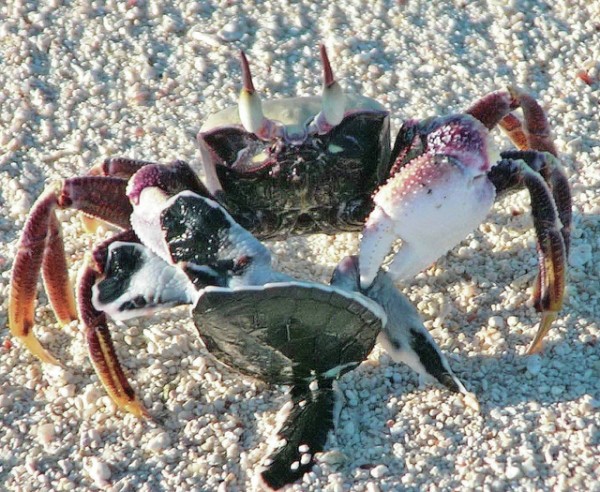Published in the Ocean Watch column, Honolulu Star-Advertiser © Susan Scott
March 7, 2016
In my Feb. 22 column, I wondered about the origin of the odd fish name “Moorish idol.” About that, Honolulu reader Ned Conklin emailed an excerpt from a 2007 book, “When Languages Die,” by K. David Harrison (Oxford University Press).
The author writes that early European explorers and naturalists disregarded native names for plants and animals, and instead gave them English names relating to something the species reminded them of back home. For instance, on Capt. James Cook’s third voyage, 1776-80, the naturalist aboard named a damselfish with stripes a sergeant, because a British sergeant’s uniform had stripes.
 A ghost crab has a turtle hatchling caught in its pincers.
A ghost crab has a turtle hatchling caught in its pincers.
The tiny turtles must pass the crabs to make it to the ocean.
©2016 Susan Scott
Scientists later learned that the sergeant fish was actually three species. Fish namers stuck with the historic term “sergeant” but added other words to tell the species apart. Hawaii’s endemic sergeant became the Hawaiian sergeant. The damselfish with wider and longer stripes and a wide range is the Indo-Pacific sergeant. And the fish with stripes that lighten and darken, and that has a black spot on its rear, was named the blackspot sergeant.
As to the Moorish idol, Harrison writes, “A fish with a dark-colored face spotted by Capt. Cook’s crew off Hawaii received the exotic name ‘Moorish idol.’”
Another reader, Utah biologist Robert Schmidt, emailed about my Feb. 8 column on ghost crabs. Robert thought he read that ghost crabs blinded or maimed turtle hatchlings before pulling them into their burrows, thereby preventing the hatchlings from escaping. He can’t find a reference to these behaviors and asked, “Do you know anything about this?”
Only what I saw. On Tern Island I watched turtle hatchlings run the ghost crab gauntlet in their race to the ocean. If the crab got hold of only one flipper, the turtle usually got away. But when the crab got a flipper in each of its two pincers the turtle couldn’t escape.
I rescued several hatchlings before they got dragged down a crab hole, and they ran away seemingly uninjured. But I got there too late for some. Lifting one turtle from a crab hole entrance, I found its head missing and the entire body hollowed out. Efficient, those crabs.
Besides being occasional crab food, turtle hatchlings are pupu for seabirds from above and fish from below. Only about 1 hatched turtle in 1,000 makes it to adulthood.
On the bright side, healthy adult turtles are common in Oahu waters, as are ghost crabs performing their daily beach cleanups and sand aeration.
Ned and Robert, thanks for the interesting emails. But I still don’t understand why a naturalist linked the term “Moorish” with “idol.” An exotic name indeed.